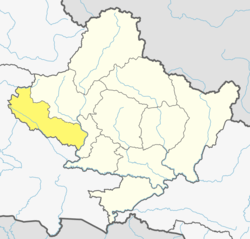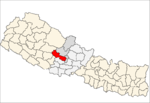Baglung District
Baglung District (Nepali: बागलुङ जिल्ला ![]()
Baglung District बागलुङ जिल्ला | |
|---|---|
District | |
 Location of Baglung (dark yellow) in Gandaki Pradesh | |
| Country | |
| Province | Gandaki Pradesh |
| Admin HQ. | Baglung |
| Government | |
| • Type | Coordination committee |
| • Body | DCC, Baglung |
| Area | |
| • Total | 1,784 km2 (689 sq mi) |
| Population (2011)[1] | |
| • Total | 268,613 |
| • Density | 150/km2 (390/sq mi) |
| Time zone | UTC+05:45 (NPT) |
| Telephone Code | 068 |
| Main Language(s) | Nepali |
| Website | Official Website |
Introduction
Baglung is surrounded by Parbat, Myagdi, Rukum, Rolpa, Pyuthan and Gulmi districts. It has 59 Village Development Committees and one Municipality. Baglung has a moniker of "District of suspension bridges" as there are numerous suspension bridges. It is a hilly district, most of the population settled in the sides of the rivers. Fertile plains situated in the either sides of the rivers are used for farming. Headquarters of Baglung District is Baglung Municipality which is located on a plateau overlooking the holy - Kali Gandaki. Like Nepal, Baglung is also diverse in religion, culture, ethnicity, altitude, temperature etc. Hinduism and Buddhism are the major religions. Magar, Chhetri, Brahman, Newar, Gurung, Chhantyal and Thakali are the major ethnic groups living in Baglung.
Baglung is rich in herbal medicinal plants. Rice, Corn, Millet, Wheat and Potato are the major crops of Baglung. Small scale mining mostly for Iron and Copper was a major activity in Baglung in the past. However, due to economics of operating small mines most have closed since. Slate mining remains the most widespread form of mining in present times. Slate mined in Baglung is considered excellent for roofing.
Baglung Municipality, Hatiya- Galkot and Burtibang are the main trading centers of Baglung. Galkot, Kusma and Burtibang are connected with the district headquarters Baglung Bazaar by roads. Baglung is served by Nepal Electricity Authority and various small local hydropower plants. Recently, telephone has been accessible in almost all villages of Baglung. Baglung is considered to be one of the politically most conscious districts and it plays a significant role in the Nepali politics.
Geography and Climate
Highest temperature at the lowest elevation of baglung rises up to about 37.5 degrees Celsius in summer and the lowest temperature at Dhorpatan falls up to about −15 degrees Celsius in winter. The elevation of Baglung varies from about 650 meters at Kharbang to about 4,300 meters in Dhorpatan.
| Climate Zone[2] | Elevation Range | % of Area |
|---|---|---|
| Upper Tropical | 300 to 1,000 meters 1,000 to 3,300 ft. |
2.8% |
| Subtropical | 1,000 to 2,000 meters 3,300 to 6,600 ft. |
37.1% |
| Temperate | 2,000 to 3,000 meters 6,400 to 9,800 ft. |
39.4% |
| Subalpine | 3,000 to 4,000 meters 9,800 to 13,100 ft. |
18.6% |
| Alpine | 4,000 to 5,000 meters 13,100 to 16,400 ft. |
2.1% |
Demographics
At the time of the 2011 Nepal census, Baglung District had a population of 268,613. Of these, 92.3% spoke Nepali, 5.4% Magar, 0.5% Kham, 0.5% Chhantyal and 0.5% Newari as their first language.[3]
Administration
The district consists of 10 Municipalities, out of which four are urban municipalities and six are rural municipalities. These are as follows:[4]
- Baglung Municipality (the district's headquarter)
- Dhorpatan Municipality
- Galkot Municipality
- Jaimuni Municipality
- Bareng Rural Municipality
- Khathekhola Rural Municipality
- Taman Khola Rural Municipality
- Tara Khola Rural Municipality
- Nisikhola Rural Municipality
- Badigad Rural Municipality
Former Village Development Committees
Prior to the restructuring of the district, Baglung consisted of the following municipalities and Village development committees:
|
|
|
|
2015 Nepal earthquake
The district was moderately affected by an April 2015 Nepal earthquake. Many old buildings sustained damages and a few collapsed. Since then many of the buildings have been rebuilt by the owners.
See also
References
- "National Population and Housing Census 2011(National Report)" (PDF). Central Bureau of Statistics. Government of Nepal. November 2012. Archived from the original (PDF) on 2013-04-18. Retrieved November 2012. Check date values in:
|accessdate=(help) - The Map of Potential Vegetation of Nepal - a forestry/agroecological/biodiversity classification system (PDF), . Forest & Landscape Development and Environment Series 2-2005 and CFC-TIS Document Series No.110., 2005, ISBN 87-7903-210-9, retrieved Nov 22, 2013
- 2011 Nepal Census, Social Characteristics Tables
- "स्थानिय तह" (in Nepali). Ministry of Federal Affairs and General Administration. Archived from the original on 31 August 2018. Retrieved 1 September 2018.
| Wikimedia Commons has media related to Baglung District. |
